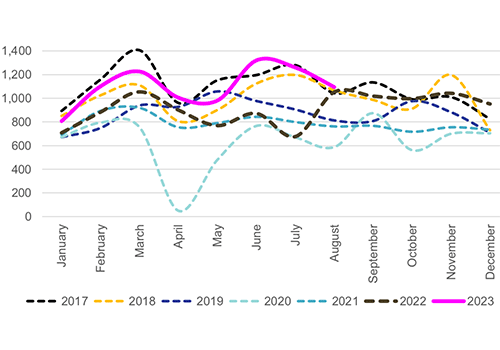Domestic demand for vehicles in August decreased by just over 13% on a monthly basis, from 1 260 units in July to 1 094 units. On an annual basis, vehicle sales improved by a meagre 4.0% in August, which is significantly lower than consistent double-digit growth figures witnessed in August 2022.
This is the analysis of stock brokerage Simonis Storm (SS), which noted that the new vehicle market is currently experiencing a resurgence, driven by improvements in the supply chain landscape.
“Although certain high-end brand categories continue to encounter supply chain challenges, they represent a minority within the overall sample. Dealers have reported that new vehicle sales constitute a significant 80% of total sales, with the remainder comprising pre-owned vehicle sales. Engagements with industry stakeholders have revealed that the pre-owned vehicle market is now decelerating, following its previous boom during the period of high supply chain disruptions in 2022”, reads the SS report.
They pointed out that dealers capitalised by increasing their profit margins on pre-owned vehicles to record highs, effectively compelling consumers to make purchases at retail prices rather than trade-in values. SS emphasised that consequently, demand for pre-owned vehicles has experienced a notable decline, prompting dealers to adjust their profit margins downwards in response.
For the year-to-date (YTD), annual vehicle sales grew by almost 30%, as the resilience of local demand for vehicles set a remarkable YTD average of 1 099 vehicles sold per month in 2023, which is the highest it has been since 2018.
SS stated that this is largely due to demand from individuals purchasing through dealerships, accounting for 92% of sales YTD, but also due to increasing demand from rental companies taking up the remaining 8% of sales YTD.
Namibia Statistics Agency (NSA) data indicated that vehicle inflation experienced a year-on-year increase of 7.6% in August 2023.
“Nevertheless, analysis of suggested retail prices provided by the National Association of Automobile Manufacturers of South Africa (NAAMSA) reveals that passenger vehicles have experienced a more pronounced inflationary trend, with an average 10.9% y/y increase,” the SS report states.
This surge is primarily propelled by passenger vehicles (up 13.1% y/y), light-commercial vehicles (up 13.6% y/y), medium commercial vehicles (up 25.6% y/y), and extra-heavy commercial vehicles (up 16.0% y/y), while the average price of heavy commercial vehicles witnessed a decline of 13.5% y/y in August 2023.
“This shift in consumer behaviour can be attributed to the elevated repo rate of 7.75% and prime rate of 11.5%, which have acted as deterrents, discouraging consumers from seeking vehicle loans due to the associated burden of higher interest rate payments,” SS noted.


